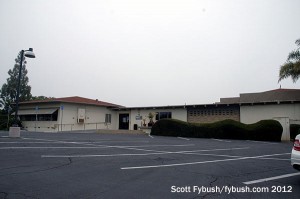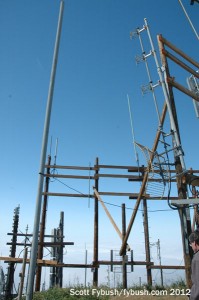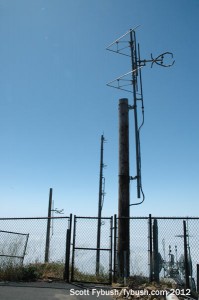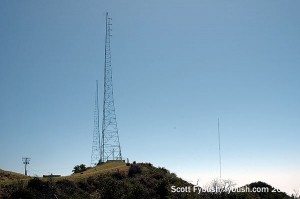NorthEast Radio Watch 12/15/2025: NYC Morning Shakeup
In this week’s issue… NYC morning shows exit - Carton back amidst WFAN shakeup - FM signing off in Canada - More radio centennials
Text and photos by SCOTT FYBUSH
This week’s Tower Site of the Week features two latecomers: one of the nation’s newest public radio operations and one of the last major mountaintop sites to be developed for broadcast use, all along the scenic central California coast.
We start with the public radio station: KCLU-FM (88.3 Thousand Oaks) turns just 20 this year, which means, remarkably, that two decades ago there was no local public radio for more than a million residents of Ventura and Santa Barbara counties. At the eastern edge of Ventura County, California Lutheran University began filling that void with KCLU’s debut in 1994.
From its small start in a cramped studio in Mount Clef Hall, KCLU enjoyed one of the fastest growth spurts in the recent history of public radio: it added a Santa Barbara translator, K272DT (102.3) in 1999, upgraded its main signal from class A to B1 in 2002 from a site in the hills between Thousand Oaks and Oxnard, enhanced its Santa Barbara service with the purchase of a commercial AM station, KIST (1340, now KCLU AM)…and then, in 2011, cut the ribbon on a spiffy new two-story studio building on CLU’s north campus.
Actor Larry Hagman and his wife, Maj, who lived nearby in Ojai, led the fundraising campaign f0r the new building; when we stopped by in April 2012, GM Mary Olson was leading one of the first membership drives out of the new community room that dominates the first floor of the facility. When this atrium space isn’t filled with phone banks, it’s used for all sorts of community events and meetings. It opens into a lounge area that in turn leads to the stairway up to the second-floor lobby – and that stairway is lined with a very impressive array of awards for such a young station.

Upstairs, KCLU’s new digs are compact but efficient: there’s a main air studio that doubles as an interview space, another production booth adjoining it, and a newsroom, which was a much-desired feature of the move.
The simple rack room is down the hall – and check out the nifty nameplates on each door, which feature prominent predecessors of the current staffers. (And yes, I want a Murrow nameplate for my door, too!)
From Thousand Oaks (and the sites in and around Ventura we showed you last week), our next stops on this 2012 ramble up and down the coast were an hour or so away in Santa Barbara. We’ll begin our Santa Barbara overview with a quick exterior peek at the city’s oldest TV station, ABC affiliate KEYT (Channel 3), where the studios enjoy a multimillion-dollar view from high up on Miramonte Drive, on a hilltop just west of downtown Santa Barbara.
That gray sky above KEYT on this Saturday is actually heavy coastal fog, as you can see in the photo above from our next stop, Gibraltar Peak.
It’s a twisty road that leads up from near sea level, in the residential neighborhoods in the foothills on Santa Barbara’s north side, to this promontory some 2150 feet above sea level and not far above the fog banks. If not for the fog, we’d have a spectacular view here, a commanding vista up and down the coast from Ventura to the east all the way past Goleta and Isla Vista to the west. (You’d pay many millions of dollars for a house with the same view.)
Remarkably, this spot didn’t enter broadcast use until the latter half of the 1970s, when classical KDB-FM (93.7) moved up here after nearly two decades atop the KDB (1490) rooftop AM tower downtown.
In the years since then, KDB has been joined by five more full-power FM signals, five translators and two on-channel boosters at this busy multi-user site, where there’s also a plethora of two-way users, ham repeaters, low-power TVs and assorted other bits and pieces of RF.
To placate the neighbors, there are no big towers here (even KDB’s mast is less than 80 feet tall), just a bunch of telephone poles supporting most of the antennas up here. That posed something of a problem when the “Tea Fire” struck this area in November 2008. The flames raging up the hill claimed many of those poles, and the antennas on them, and several small transmitter buildings, too. (The indispensable Doc Searls has a photo set of the aftermath on Flickr, if you’re curious.)
By the time we made our visit three and a half years later, the damage had mostly been cleared away, and the Gibraltar site had been largely rebuilt. From the turnoff on Gibraltar Peak Road, the road from the gate drops sharply down into a saddle before rising up again around a hairpin that leads to the transmitter plateau up here. KDB sits alone at the north end, and in the center of the site there’s a new concrete-block transmitter building that appears rather more fireproof than its ramshackle wooden predecessors. The new building appears to have mostly two-way tenants inside, from what I could tell.


At the south end of the site, there’s an older block building that holds most of the FMs here. It’s crowned with a matrix of wooden poles holding a rather wide variety of antennas, some still in use, others apparently defunct.
Several FM antennas on very short towers line the edge of the roadway leading down to that lower building, hanging almost off the edge of the cliff.
So who all is up here? The full-power lineup, in addition to KDB, has included KQSC (88.7), the classical relay of Los Angeles’ KUSC (91.5); KSBX (89.5), a very low-power relay of public station KCBX (90.1) up the coast in San Luis Obispo; modern rock KJEE (92.9 Montecito); KSBL (101.7 Carpinteria) and KRRF (106.3 Goleta).
I say “has included” because a series of signal shuffles had already moved KSBL off this site by early 2012, and would move KRRF off the site later that year. KSBL is now at a site to the west, higher up in the Santa Ynez mountains on the way up to Broadcast Peak, which we’ll see in our next installment; KRRF was moved down to Oak View, in the Ventura market. (And KSBL has a CP to move again, becoming a class B station that would operate from way, way offshore in the Channel Islands, though it’s not clear it will ever be built.)
I believe that’s KRRF’s three-bay Shively , with lots of beam tilt, hanging off the “matrix” in the photo above at left. I’m pretty sure KQSC’s four-bay antenna is in the middle in the photo above at right, and I think KJEE and KSBX are in this picture, too.
Inside that lower building, KQSC’s big BE transmitter is by far the most powerful, tucked in a niche just to the right of the door. KJEE uses a Larcan/TTC transmitter in the next rack over, next to Pacifica’s K254AH (98.7), which relays KPFK (90.7 Los Angeles).
To the left of the door, a bunch of lower-powered signals come from little transmitter racks all lined up in neat rows extending back into an alcove off the main transmitter room. KSBX is here, as are the two boosters at the site, KDAR-1 (98.3), a powerful booster of Salem’s KDAR (98.3 Oxnard), and KMRO-FM-2 (90.3), repeating KMRO (90.3 Camarillo). The remaining translators here include K210AD (89.9), relaying religious KLFH (89.5 Ojai); K218CP (91.5), a Calvary satellator relaying KAWZ from Twin Falls, Idaho; EMF’s K227BI (93.3), somehow relaying K-Love outlet KLVH (88.5 San Luis Obispo) notwithstanding KQSC right there on 88.7; and KCLU’s 4-watt translator, K272DT (102.3).

While this part of Gibraltar has been in broadcast use only since about 1977, there’s a much older site just up the hill.
KGUD (990) and KGUD-FM (99.9) signed on together in 1963, with a potent 37 kW on FM and a rather less-potent 500 watts, daytime-only, from two self-supporting towers for which the stations were granted a waiver of the usual painting and lighting requirements.
That third little AM tower came along two decades or so later, with an elevated counterpoise instead of a conventional ground system. Adding that extra tower allowed AM 990 to run 5000 watts by day and add 500 watts of night service. By then, KGUD/KGUD-FM had become KTYD/KTYD-FM; in later years, under Clear Channel ownership, the AM station took the KTMS callsign that had a heritage in the market on AM 1250, today’s KZER.
When Clear Channel exited the market a few years back, these stations went to Rincon Broadcasting, which is a sister to Gold Coast Broadcasting down in Ventura – and that’s why this site is also home to KCAQ-FM6, one of four on-channel boosters that extends the rhythmic top-40 of KCAQ (104.7 Oxnard) to the edges of its coverage area.
The Gibraltar tower farm is just one of two big mountaintop sites serving Santa Barbara; in next week’s installment, we’ll take the long drive up to the other one, as well as checking out a remarkable triplexed AM site, and some studios, too!
Thanks to Aaron Read, KCLU’s Lance Orozco and J.D. Strahler, formerly of Cumulus, for the tours!

As we announced a few weeks ago, the 2026 edition of the Tower Site Calendar will be the last.
We began publishing it 25 years ago, and the broadcast landscape is radically different now.
Radio World just ran an excellent article about us if you want to know more.
Once it’s gone, that’s it. We won’t be printing any more.
Thank you to everyone who saw our announcement and rushed to buy it. We appreciate you.
(There are some calendars from previous years if you want more of a tower photo fix — all under $5.)
But don’t wait to get this year’s Tower Site Calendar — buy it now!
We are selling the Broadcast Historian’s Calendar again this year, but we have that in an even smaller quantity — definitely don’t hesitate for that.
And visit the Fybush Media Store to check out our selection of books and videos, too!
And don’t miss a big batch of Santa Barbara IDs next Wednesday, over at our sister site, TopHour.com!
Next week: Broadcast Peak and the AM triplex, Santa Barbara, 2012
In this week’s issue… NYC morning shows exit - Carton back amidst WFAN shakeup - FM signing off in Canada - More radio centennials
In this week’s issue… Veteran newsman returns - Remembering NY's Leitner, RI's Jones - CT AM saved - Maine AM moves - "Indie" adds suburban signals
In this week’s issue… Scripps stations face takeover - Sinclair moves more affiliations - CT stations sold - Maine AM surrendered - Remembering WVBR's Shapiro, WABC's Morgan
In this week’s issue… CT TV legend succumbs to cancer - Remembering PA's Adams - FCC still stalled by shutdown - Pittsburgh morning host exits